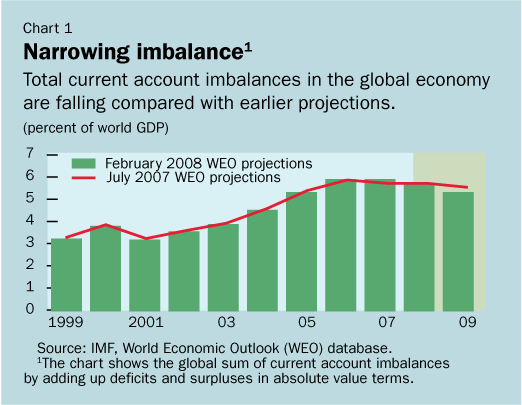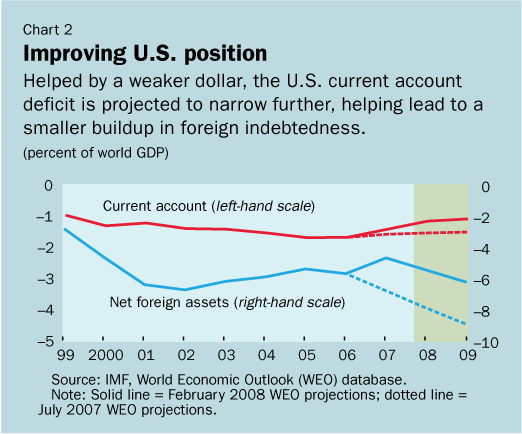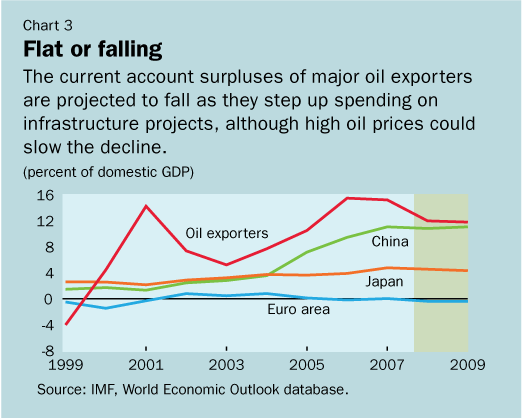
Typical street scene in Santa Ana, El Salvador. (Photo: iStock)
IMF Survey: IMF Sees Global Imbalances Narrowing, But More to Be Done
February 19, 2008
- Global imbalances have narrowed compared with earlier forecast
- But more needs to be done by major surplus and deficit nations
- Tangible further progress would reassure markets during heightened uncertainty
Global economic imbalances appear to have peaked in 2006-07 and are now projected to narrow faster than earlier forecast, but more remains to be done to correct a worrying disequilibrium in the world economy, according to IMF analysis.

A slowing economy in the United States has helped narrow the U.S. current account deficit faster than previously projected (photo: Rob Crandall/ Stock Connection)
Multilateral consultations
With slower growth and a weaker dollar, the U.S. current account deficit has narrowed faster than previously projected, while surplus nations have made some progress in implementing policy plans made under an IMF-sponsored process to reduce the imbalances.
But as recent events in global financial markets have shown, market disruptions can occur abruptly and in unexpected ways. Thus the stakes remain high to help smoothly unwind still-large global imbalances. "The key challenge for policymakers is to implement the measures that are needed to sustain the global expansion while reducing potentially disruptive imbalances," said John Lipsky, IMF First Deputy Managing Director.
IMF-backed framework
Through a new process of multilateral consultations, launched in June 2006, the IMF brought together key players in the global economy—China, the euro area, Japan, Saudi Arabia and the United States—to work to reduce the imbalances in an orderly and growth-friendly manner.
The goal was to avoid an abrupt unraveling of the imbalances caused by the large current account deficit in the United States and big surpluses in some Asian and oil-producing countries. The strategy adopted by the IMF aimed to encourage "steps to boost national saving in the United States, including fiscal consolidation; further progress on growth-enhancing reforms in Europe; further structural reforms, including fiscal consolidation, in Japan; reforms to boost domestic demand in emerging Asia, together with greater exchange rate flexibility in a number of surplus countries; and increased spending consistent with absorptive capacity and macroeconomic stability in oil-producing countries."
After almost a year of consultations, the participants' policy plans consistent with these aims were outlined in a statement released in April 2007 and the IMF committed itself to monitor progress with implementation.
Changing circumstances
Since then the global economy has changed dramatically. Market turmoil—triggered by the U.S. subprime mortgage crisis—has shaken confidence in money and credit markets worldwide. Against concerns about a "credit crunch" and a possible U.S. recession, policy attention in the United States has shifted to aggressive monetary policy easing and fiscal stimulus to support the economy.
Financial market disruptions have also directly affected Europe and sizable financial losses related to U.S. complex financial products have hit many European banks. Slower U.S. growth, financial dislocations and tighter lending conditions more broadly have raised concerns about a broader global economic slowdown.
Smaller U.S. deficit
With a slowing economy and a weaker dollar, the U.S. current account deficit has narrowed faster than expected (to about 5½ percent of GDP in 2007). Moreover, current projections for the deficit are markedly lower compared with projections when the consultations were under way (see Chart 1).

The U.S. net foreign asset position, meanwhile, has remained broadly stable, continuing to reflect valuation gains and return differentials in favor of U.S. foreign investment. With a better starting point and smaller flow deficits, the trajectory for U.S. net external assets has also substantially improved since last July. Overall, global imbalances appear to have peaked last year and are now projected by the IMF to narrow faster than at the time of the consultations (see Chart 2).

Still needed?
So has the consultation and IMF-monitoring process been overtaken by recent events?
IMF analysis suggests that, if anything, events have made joint action to curb the imbalances more relevant, and just as important, as when the process began. Indeed, the dual objectives of the consultations—to help facilitate an orderly unwinding of imbalances while ensuring the unwinding is carried out in a manner supportive of global growth—have gained new significance in light of recent financial turmoil and possibly slower global growth. Specifically,
• In a period of more fragile market confidence and still-large imbalances, risks of a disorderly adjustment remain a clear concern. Moreover, sustained large foreign losses on holdings of U.S. external assets, as well as reduced confidence in the asset quality of complex financial products (such as mortgage-backed securities and collateralized debt obligations), suggest that foreign financing could be less forthcoming in the future.
• An asymmetric pattern of currency movements against the U.S. dollar—which has fallen noticeably less against the currencies of some key surplus countries—continues to underscore the need for broader-based adjustment. Continued asymmetric adjustment, on the other hand, risks fueling protectionist sentiment, particularly if global growth were to slow.
• Given the unfolding U.S. slowdown, falling house prices, and tighter credit conditions, one might expect to see some normalization in U.S. household saving from its low levels. But the prospects for softer U.S. domestic demand going forward would need to be balanced by stronger domestic demand elsewhere to avoid a deeper slowdown in global growth.
• Volatile oil prices—touching new highs amid tight market conditions—could slow a narrowing of global imbalances, given still-strong demand from emerging markets and ongoing concerns over supply. Oil price spikes could add to the imbalance problem by leading to wider deficits for importers such as the United States and larger surpluses for oil exporters such as Saudi Arabia (see Chart 3).

Recent policy progress ...
The IMF has been monitoring progress with the policy plans of the five participants and finds there have been welcome gains on several fronts since the consultations.
• China has made some progress with respect to rebalancing growth toward domestic demand (a focal point of the upcoming fiscal budget) and taken incremental steps toward greater currency flexibility;
• in Saudi Arabia, the authorities have ramped-up spending on needed social and economic infrastructure;
• in the euro area, member states have taken measures to accelerate financial integration and to better align incentives in labor markets;
• Japan has made some progress in reforming product markets and in fiscal consolidation; and,
• in the United States, alongside a narrowing current account deficit, the major advance for policies has been the continued decline in the federal budget deficit through FY 2007, ahead of earlier projections, although the deficit is expected to widen temporarily in FY2008-09 due to the impact of the cyclical downturn and the recently approved stimulus package.
... but more to do
Overall, the progress to date has been encouraging, but more remains to be done. Moreover, in light of recent developments, the policy plans in some key areas could be advanced, but flexibly to take account of the fast-changing global context:
• In China, a faster rate of renminbi appreciation would allow for more broad-based exchange rate adjustment and would create much needed space for monetary policy tightening to keep inflation pressures at bay. In addition, advancing fiscal plans to support domestic consumption would help rebalance demand and support the global economy in the event of a sharper slowdown.
• In Saudi Arabia, rising inflation pressures suggests maintaining spending priorities in key areas such as infrastructure to help relieve supply bottlenecks.
• In the euro area, large losses suffered by European banks stemming from the U.S. subprime crisis draw attention on the need not only to deepen integration but also to strengthen financial stability arrangements. Effective product market reforms are needed to improve the business climate and sustain growth. Also, labor market reforms (including improving mobility) are needed to boost productivity and labor utilization.
• In Japan, with limited policy space to address a possible economic slowdown, structural reform measures remain central to enhance growth prospects and strengthen domestic demand, with priorities on enhancing labor flexibility and participation and to boost productivity through deregulation.
• And finally, in the United States, a slowdown in activity is challenging the steady progress made in reducing the federal deficit. But longer-term pressures on public finances from aging and entitlements underscore the importance of adhering to the authorities' medium-term fiscal consolidation objectives. Thus, while timely fiscal stimulus is justified by the cyclical situation, it should be kept strictly temporary and targeted, to effectively insure against a deeper downturn without jeopardizing medium-term budgetary goals.
Thus, overall, the plans outlined through the consultation process continue to provide a relevant roadmap for policies that both help serve national interests and contribute to reducing broader risks to the global economy that are a collective concern. From a global perspective, against the background of ongoing financial turmoil and a clouded outlook for the global economy, tangible further progress on these plans by all participants would provide much-needed reassurance at a time of heightened market uncertainty.
Comments on this article should be sent to imfsurvey@imf.org.


